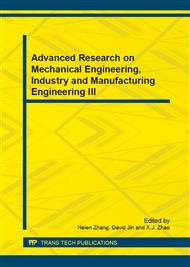p.128
p.132
p.137
p.141
p.145
p.150
p.154
p.163
p.167
The System Design of Granular Bulk Materials Continuous Conveyor Weighing Measurement
Abstract:
For continuous transportation of granular bulk materials measurement and weighing is important link in industrial and agricultural production, warehousing and product flows. Improve said heavy of precision and speed is the key of dynamic measurement, and traditional for the continuous delivery of materials weighing system can not meet the requirements of quickly weighed and measured accurately, while sometimes variable, and nonlinear and random, factors in actual process in the of interference, in order to overcome these factors on continuous conveying material measurement system of effect, this article based on RBF Neural network model for foundation made a dynamic clustering algorithm optimization strategy.By means algorithm calculated the center of the base function, further extended RBF Neural network constants from hidden layer to output layer , then using least-squares method calculates the weight matrix to determine the final network structure and main parameters. This article on measurement of dynamic process has simulation test research, and BP neural network for effect comparison, simulation results indicates that, based on RBF of neural network on continuous conveying bulk material measurement control system is more effective, and weighing accuracy and speed is improved, in order to achieve the continuous delivery of materials weighing process optimization control, and at the same time provides an effective way to solve the existing problems of this type of system.
Info:
Periodical:
Pages:
145-149
Citation:
Online since:
August 2013
Authors:
Price:
Сopyright:
© 2013 Trans Tech Publications Ltd. All Rights Reserved
Share:
Citation:


